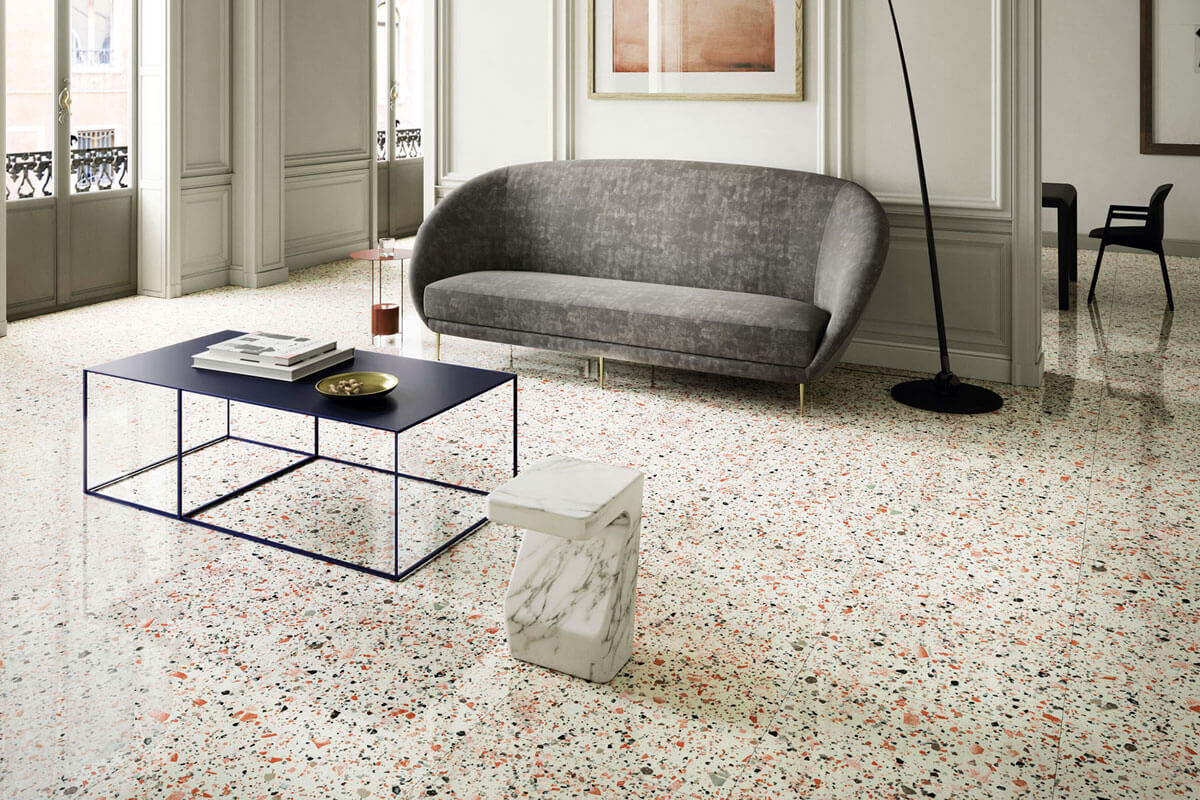Terrazzo Floors are composite surfaces made from chips of marble, glass, granite, or recycled materials embedded in cement or epoxy, then ground and polished smooth. These floors last 40 to 100 years with proper care, making them popular in airports, schools, hospitals, and modern homes. You get a durable, customizable surface that handles heavy traffic while offering endless design options at costs ranging from $9 to $35 per square foot installed.
What Are Terrazzo Floors Made Of?
Terrazzo combines two main components: a binder (cement or epoxy resin) and decorative aggregates like marble chips, glass, granite, or shells. The mix gets poured, cured, ground smooth, then polished to reveal the speckled pattern beneath.
Epoxy terrazzo uses epoxy resin as the binder, offering thinner installations (around ¼ to ⅜ inch), faster curing times, and more color flexibility than traditional cement systems. Cementitious terrazzo provides a classic look and works better outdoors, though it takes longer to cure and requires a thicker profile. Modern recycled glass aggregate comes from crushed bottles and windows, while reclaimed marble chips arrive from quarries and construction waste. These sustainable materials can comprise up to 70% of the finished floor by volume.
The aggregate chips determine your floor’s final appearance. Marble chips create traditional looks in whites, grays, and earth tones. Glass chips add vibrant pops of color and improve sustainability scores. Mother-of-pearl and polished metals bring luxury flooring finishes to high-end projects, though they cost significantly more than standard aggregates. Divider strips (thin metal strips, usually aluminum or brass) create patterns, control cracking, and separate different color zones in your floor design.
The word “terrazzo” derives from the Italian word for “terrace,” coined when Venetian mosaic workers in 15th-century Italy began recycling marble remnants from their slab work. These resourceful craftsmen from the Friuli region mixed off-size marble chips with clay to build terraces around their homes, creating one of the earliest recycled building materials.
How to Install Terrazzo: Methods and Best Practices
You need professional terrazzo contractors for installation because one mistake proves costly to fix. The installation method you choose affects both price and performance.
Poured terrazzo (also called thin-set) is the most common method, where installers pour the epoxy or cement mixture directly onto your prepared subfloor. This creates a seamless, monolithic surface without grout lines. The process involves pouring, curing for several days, grinding the surface with diamond pads, and polishing to the desired sheen. Terrazzo tiles offer an easier installation similar to regular tile work, costing less in labor but sacrificing the seamless look and unlimited customization of poured systems. Tiles come in standard sizes like 24×24 inches and work well for smaller projects or budget-conscious renovations.
Monolithic installation is the most budget-friendly poured method, bonding directly to the concrete slab without a cushion layer. Sand-cushion terrazzo includes a layer between the slab and terrazzo, used in exterior applications where movement occurs. This decorative flooring system requires proper subfloor preparation, precise mixing ratios, controlled curing conditions, and skilled grinding techniques. You cannot DIY terrazzo installation. The specialized equipment (planetary grinders, diamond polishing pads) and technical knowledge required make this strictly a job for certified terrazzo contractors.
While terrazzo flooring dominates most applications, the same composite material technique extends to terrazzo countertops, walls, stairs, and decorative panels, demonstrating the material’s versatility beyond just floor surfaces.
Cost Breakdown and Lifecycle Value
Terrazzo flooring costs between $9 and $35 per square foot installed in 2025, with prices varying by installation method, aggregate choice, and design complexity. Terrazzo tiles run $9 to $22 per square foot, while poured terrazzo ranges from $15 to $35 per square foot due to higher labor requirements.
For a standard 200-square-foot room, expect to pay $2,800 to $3,400 for basic terrazzo tile installation or $4,000 to $7,000 for poured terrazzo with standard aggregates. Custom patterns with multiple colors and divider strip patterns can push costs to $100+ per square foot. Glass aggregates cost less than marble chips, which cost less than luxury options like mother-of-pearl. A 50-pound bag of marble chips runs $25 to $100 depending on quality and color. Labor accounts for $5 to $20 per square foot, with complex installations demanding the higher end.
This hard surface flooring provides exceptional lifecycle cost value. These floors last 40 to 100 years with proper maintenance, compared to carpet (5 to 10 years), vinyl (10 to 20 years), or even hardwood (25 to 50 years). When you calculate cost per year of use, terrazzo often beats cheaper alternatives. The low maintenance requirements (just sweeping and occasional mopping) save thousands in upkeep compared to materials like soft flooring options such as carpet that need professional cleaning, or wood floors requiring periodic refinishing. Schools, airports, and hospitals choose terrazzo specifically because the long-term economics work better than frequent carpet or tile replacements.
When comparing terrazzo to semantically related alternatives like polished concrete, terrazzo offers superior customization and design flexibility, though polished concrete may provide a lower initial cost with a more industrial aesthetic.
Design Trends and Styling Tips in 2025
Bold, colorful aggregates with larger chips are dominating 2025 terrazzo trends. Designers are using vibrant marble, quartz, or glass chips in warm terracotta hues and cool blue tones against contrasting backgrounds to make statement floors.
Matt finishes are replacing glossy surfaces for a refined, sophisticated aesthetic. These soft-textured looks reduce reflections and create an organic feel perfect for modern homes seeking understated luxury. Monochrome terrazzo in blacks, whites, and grays brings texture to minimalist spaces without overwhelming the design. Pastel pops in soft greens, blues, and pinks inject playful sophistication into bathrooms and kitchens. Black and white terrazzo creates dramatic, high-end looks in contemporary interiors.
Full bathroom walls and floors covered in terrazzo create seamless, spa-like spaces. Pairing speckled finish terrazzo with brass or matte black fixtures delivers a modern premium surface feel that dominates 2025 design magazines. Over 58% of commercial construction projects now integrate sustainable materials, boosting terrazzo use in green building projects. Nearly 30% of high-end residential homes are incorporating terrazzo in kitchens and bathrooms. Material blending is trending, with designers pairing terrazzo tiles alongside wood kitchen islands, concrete countertops, or marble accent walls for layered, eclectic looks in open-plan spaces.
Venetian terrazzo patterns featuring larger marble chips and traditional earth tones continue appealing to homeowners seeking historical authenticity in their building interior designs, honoring the material’s Italian heritage while incorporating modern installation techniques.
Maintenance, Repair and Restoration
Daily dust mopping and weekly damp cleaning with neutral pH cleaners keep terrazzo looking fresh. This simple routine makes terrazzo one of the easiest high-end floors to maintain.
Use only pH-neutral cleaners designed for hard surfaces. Acidic or alkaline products dull the polished surface and accelerate wear. Mix a quarter teaspoon of mild dish soap with warm water for routine cleaning, or use specialized terrazzo cleaners like Prosoco 2010. Dust mopping daily removes abrasive grit that can scratch the surface. Weekly damp mopping with neutral cleaner keeps the floor clean without residue buildup. Heavily soiled areas need mechanical buffing with a soft brush and neutral cleaner, followed by clean water rinse.
Floor restoration involves stripping old sealers every 6 to 12 months and reapplying water-based acrylic sealer according to manufacturer instructions. New floors typically need two or more coats of sealer, providing good sheen for 45 to 60 days before additional coats become necessary. For worn terrazzo, professional restoration services can hone away the scratched surface layer to reveal fresh material underneath, then polish to your chosen finish (matte or glossy). Cracks and chips get filled with tinted epoxy or cement containing matching aggregates, then ground smooth to blend with surrounding areas. Properly maintained terrazzo can last 100 years or more. When restored rather than replaced, terrazzo saves significant money and waste.
A unique advantage of this flooring system is its antimicrobial properties. The non-porous, seamless surface prevents bacteria, mold, and mildew growth, making terrazzo ideal for healthcare facilities, educational institutions, and food service areas where infection control matters most. The smooth surface requires no harsh chemicals for sanitation and supports routine cleaning protocols effectively.
When Not to Use Terrazzo (Risks and Limitations)
High initial cost is terrazzo’s biggest drawback. Installation requires skilled labor and specialized equipment, making it one of the most expensive flooring options upfront. Budget-conscious projects may find better value in alternatives like polished concrete or luxury vinyl.
Epoxy terrazzo peels and fades when exposed to outdoor elements and UV light. For exterior applications in freeze climates, cement-based terrazzo performs better but still faces cracking risks from ice expansion. Terrazzo does not retain heat well, making floors uncomfortably cold during winter months unless you install radiant heating or insulation beneath. Walking barefoot on terrazzo in cold weather feels harsh compared to carpet or wood. Polished terrazzo becomes quite slippery when wet, creating fall risks for young children or elderly family members. Ask contractors about anti-slip additives or textured finishes for moisture-prone areas.
Structural movement or improper installation leads to cracking that requires professional repair. Buildings that settle or shift make poor candidates for terrazzo unless you use expansion joints and proper underlayment systems. Unsealed or poorly sealed terrazzo is porous and allows dirt, water, and oil to penetrate deep into the surface, creating stains that prove difficult to remove. For projects requiring frequent design changes or flexibility, terrazzo’s permanence becomes a liability rather than an asset. The material’s durability means you live with your design choice for decades.
Key Takeaways for Your Terrazzo Project
1. Sustainability Credentials: Terrazzo floors can contain up to 70% recycled content from post-consumer glass, reclaimed marble, and salvaged materials. Zero-VOC epoxy systems improve indoor air quality and help projects earn LEED certification points. The material’s 40 to 100-year lifespan dramatically reduces replacement waste.
2. Professional Installation Required: Do not attempt DIY terrazzo installation. The process demands specialized grinding equipment, precise mixing knowledge, and years of experience. One installation error can cost thousands to repair.
3. Long-Term Value Over Initial Cost: While terrazzo costs more upfront ($9 to $35 per square foot), its minimal maintenance needs and multi-decade lifespan provide lower total cost of ownership than cheaper alternatives requiring frequent replacement.
4. Design Flexibility: Terrazzo offers nearly unlimited customization through aggregate choices, colors, patterns, and chip blend options. You can incorporate logos, geometric designs, or custom color schemes impossible with pre-manufactured flooring.
5. Climate and Application Matching: Choose cement terrazzo for outdoor applications and epoxy terrazzo for interior spaces. Consider radiant heating in cold climates and anti-slip treatments for moisture-prone areas.
6. Health and Safety Benefits: The non-porous, antimicrobial surface naturally resists bacteria and mold growth without chemical additives. This makes terrazzo particularly valuable in healthcare settings, schools, commercial kitchens, and other environments where hygiene ranks as a top priority.
Terrazzo flooring combines durability, sustainability, and design freedom in a single material. Understanding costs, installation requirements, and maintenance needs helps you decide if this timeless flooring suits your project goals and budget constraints.





